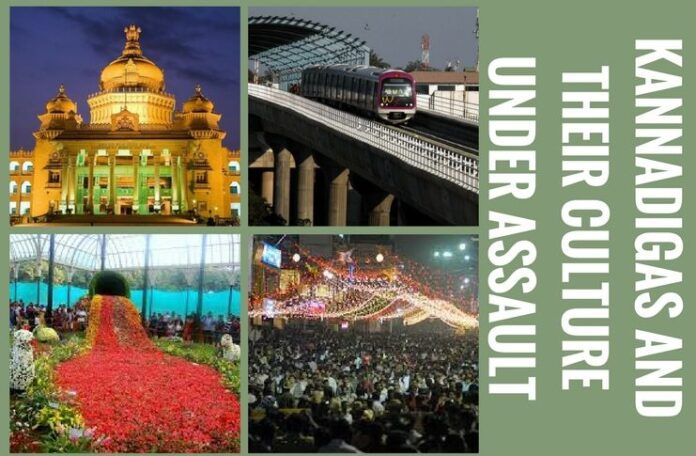
Migrants undermining Kannadigas and their Culture
[dropcap color=”#008040″ boxed=”yes” boxed_radius=”8px” class=”” id=””]W[/dropcap]alk down Brigade Road or take a stroll in Bengaluru’s most famous parks – Cubbon Park and Lalbagh – these days one will more likely hear voices in English and Hindi, a few in Tamil and Telugu. In Cinema multiplexes across the state English, Hindi, Telugu and Tamil movies are common places. And more restaurants in Bengaluru and across the state offer and give preference to North Indian and Western delicacies on the menu. Missing in conversations, theatres and menu are our very own language, movies and delicacies. Are current day migrants undermining Kannadigas and their culture?
Migrants were always welcome in Karnataka and Bengaluru since its heydeys. Given the salubrious climate of the state, central government made it the preferred destination for public sectors. Dakshina Kannada and Udupi were known as the cradle of Indian Banks. Today’s banking behemoths were yesterday’s startups in the coastal town before they were nationalized by the Congress Government led by Mrs. Indira Gandhi. With an abundance of transferable jobs in Banks and Public Sector Undertakings, the state always had to absorb a larger share of migrants from other parts of the country. Most migrants of 1960’s and 70’s accepted and respected the Kannadiga cultural identity of the state while assimilating and blending with various communities.
But 1980’s and 90’s saw young migrants pour into Bengaluru and other parts of the state. Karnataka was the first state to privatize higher education in the country and a rising young population ensured demand for professional courses of Medical and Engineering was at an all time high. Students from other parts of the country took advantage of a large number of professional colleges in the state ably assisted by managements who admitted students based on capitation fee. The education wave was followed by an Information Technology boom. With several IT firms head quartered in the State, young professionals from all over the country were recruited to fill the ever increasing job demand in the sector.
Globalization trends along with a young migrant population slowly began to chip away at the “Kannadiga” fabric of Bengaluru and Karnataka. The state was considered cosmopolitan for its welcoming nature while respecting and accepting plurality in language and religion. But cosmopolitanism was always built around Kannadigas, their culture and identity.
However, young students and brash IT professionals of 1980’s and 90’s fractured the ‘Kannada’ fabric by trying to transform the identity of the State by a foolhardy promotion of ’cosmopolitanism’ that essentially aped western culture. They never even made an attempt to learn the local language, culture or customs and mores. This led to an onslaught on Kannadigas and their culture, who were basically made to feel inferior about their language and culture in their own state.
[dropcap color=”#008040″ boxed=”yes” boxed_radius=”8px” class=”” id=””]S[/dropcap]lowly but surely locals have started to fight back. Politicians, as is their wont, failed to grasp the depth of the problem, procrastinated and finally responded to vocal calls for protection of Kannadigas and their culture with mere symbolism. Names of cities and streets were changed to give them a local flavor while Retailers were forced to display names in Kannada. When that did not silence pro-Kannada interests, they have resorted to job reservation in private sector.
The state has a chequered past with leaders and politicians who fought to protect interests of Kannadigas. Mr Ramamurthy, novelist and Sahitya Academy winner, one who is credited with creation of yellow and red Kannada flag was the first to take on the cudgels on behalf of Kannadigas who felt their language was under assault from the imposition of Hindi and Sanskrit. He was followed by Mr V Nagarajappa was popularly known as Vatal Nagaraj. Mr Vatal Nagaraj was at the forefront of the protests when theatre owners on Kempe Gowda Road showed more affinity to screen Hindi, Telugu and Tamil films while neglecting Kannada movies. Promoted by film producers and then by politicians, Mr Vatal Nagaraj initially showed guts and grit in protecting local interests. But political ambition laid him down and soon became a discredited politician as people became aware of his devious schemes of self-promotion than protecting interests of Kannadigas.
Then came the famous Gokak agitation that gained prominence after iconic film star Dr. Rajkumar offered support to the demands of agitators – declare Kannada as an official language, make Kannada compulsory in the official transaction and more importantly the need for students to learn Kannada in primary schools.
[dropcap color=”#008040″ boxed=”yes” boxed_radius=”8px” class=”” id=””]L[/dropcap]ike during the times of Gokak agitation, tension this time around is palpable and with sentiments running high, politicians must realize symbolism and reservation will not suffice. The need of the hour is to evolve policies that will promote cosmopolitanism built around Kannadigas and their cultural identity. For a start, the state must consider a TOEFL-like test in Kannada for education migrants seeking admission. Corporate India educates employees going to various countries on cultural sensibilities. Likewise it must offer to educate its employees on local language and culture. Failing which, the state could see a rise of Bal Thackeray kind of militant leader to protect the interests of locals which is unwarranted.
I am a Bengaluru-based Money Manager.
Note:
1. Text in Blue points to additional data on the topic.
2. The views expressed here are those of the author and do not necessarily represent or reflect the views of PGurus.
- Biggest Economic Accomplishment – Ending Crony Capitalism - December 13, 2019
- Mr. Rahul Gandhi must first become a Chief Minister - April 4, 2019
- How Congress lost Karnataka - May 15, 2018











Do you want Non-kannadigas who have migrated to Bangalore for a living to learn kannada. Then you need to start with having Kannada as mandatory Mother tongue language in private schools.
Who is responsible for this #assault on the very Kannadiga culture ?
1. Greedy house owners – who rent out portions to make money?
2. Kanndiga entrepreneurs – who own multi cuisine restaurants which serves anything other than Karnataka food?
3. Kannada people – who supposed to speak in their mother tongue at home are talking to their kids in English. They admit kids into English medium. They do not buy Kannada daily but page3 kinda TOI
4. Film distributors – who get other regional films to distribute and make money , which in turn doesn’t allow any screens for local Kannada films?
Who is responsible , an expat like me OR local / native Kannadigas ?
It is the local/native Kannadigas who are responsible. No one is blaming the outsiders. The author awakens the locals (like me) that there is a need for policies to strengthen the use & respect of our language & culture. Else there will be a decay of the language & culture. Expats & outsiders are always welcome, please do not feel blamed.
Mr Vijay, you say you are an expat. Can you understand, speak and write Kannada after all these years of staying in Bengaluru? Have you ever tried to learn??
Ofcourse Kannadigas are also partly responsible forthis situation. If only they were half as fanatic as some of other Indians. Do you expect them not to rent out to Non Kannadigas or charge more to them or you want them to insist on screen only Kannada movies? And what else ?? Author is only trying to highlight that the large heartedness & accommodativess of Kannadigas is being taken for granted by expats like you. Hightime, you try to assimilate with the local culture. Else days are not far, things will fall in line. Author has highlighted this aspect also.
Your comments are idiotic..I have lived in Mumbai for close 10 years, all of us spoke in Hindi a common language understood by all.Reason why I never bothered to learn marati is because 1.No one speaks to me in that language either in office or in shops2.No schools to teach middle aged employed people like me interested in learning language.Same is the scenario with respects to migrants in Bangalore.Like else where in Chennai/Hyderabad, they make do with hindi if he or she is working class or engllish if educated class.Most of their time is spent on work and on families as the life has become tortuous for many with its uncertainties.Educated people like you should have some brains to understand what the ground level situation is instead of anger.You guys have to realise that you are holding a golden duck in your hands.The IT companies have opened huge opportunities to local kannadigas by way of real estate values, jobs and employment.Instead of militant approach to propagate kannada, better approach is to build schools for learning /teaching kannada accessible to all migrants.Infact you can make good amount of money.In no time, your grouse will get addressed.Think smart and not anger.No migrant is disinterested in learning kannada,it is the accessibility in learning the language.Once they learn,they will realise treasure of literature abound in your language.Who wants to do decent thing in this country?